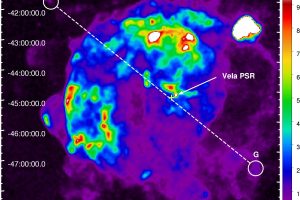Supernovae and Jet, the letter: “Indications of a Si-rich bilateral jet of ejecta in the Vela SNR observed with XMM-Newton” by F. Garcia published on A&A

The life cycle of very massive stars ends in supernovae explosions. During these violent phenomena, an amount of energy similar to that produced by the Sun during its entire lifetime,more than 10 billion years long, is released in few seconds. Besides, the atmosphere of the exploding star (the progenitor star) is ejected with a velocity in excess of 1000 km/sec.
What remains after a supernovae explosion? The core of the progenitor star becomes a compact object, surrounded by a cloud made of the plasma that was part of the progenitor star: the supernova remnant. The study of the remnants is important to understand the mechanism of supernovae explosions and its connection with the properties of the progenitor star.
The paper “Indications of a Si-rich bilateral jet of ejecta in the Vela SNR observed with XMM-Newton” by F. Garcia (Instituto Argentino de Radioastronomía), recently published on Astronomy & Astrophysics with the collaboration of S. Orlando, M. Miceli e F. Bocchino of the Astronomical Observatory and University of Palermo, shows a detailed analysis of one of the knots in the Vela supernova remnant. Both the morphology of this knot and its abundance of Si, larger than the rest of the remnant with the exception of a similar knot in the opposite direction with respect the center, suggest that it has been ejected from the interior of the progenitor star as a jet launched in two opposite directions. Similar jets have been observed in few other remnants and they are fundamental for our comprehension of supernovae explosions.
